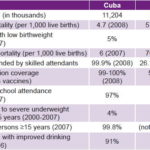This MEDICC Review was to focus exclusively on child and adolescent health in Cuba, re-introducing a theme explored in several earlier issues of the journal. However, the January earthquake in Haiti—its human toll, medical relief efforts and health system recovery—has led us to broader considerations and coverage.
Senior Editor Conner Gorry was dispatched to Port-au-Prince in February, where she spent the next month among Cuban and Latin American health professionals serving in Cuba’s Henry Reeve Emergency Medical Contingent. Leaving her tent in the mornings to hitch rides to hospitals, health posts and resettlement camps, she covered the work of these clinicians, surgeons, epidemiologists, psychologists, health educators and rehabilitation specialists—including young Haitian physicians, graduates of Cuba’s Latin American Medical School. (Once the Earth Stood Still: Cuban Rehabilitation Services in Haiti).
Gorry’s conversations, observations and insights (see also Field Notes from MEDICC at http://mediccglobal.wordpress.com) redirected our attention to the ever disturbing question: why such a stark contrast between the lives of children in Cuba and Haiti, two Caribbean countries barely 100 miles apart? And the contrast was stark indeed, well before the earthquake.
Cuba and Haiti: Childhood & Related Indicators

Sources: PAHO.Health Situation in the Americas: Basic Indicators 2009. *UNICEF. The State of the World’s Children 2009.
Part of the answer to this question lies in local political will that makes children and childhood development a priority (Protecting Children Takes More Will than Resources: Interview with José Juan Ortiz, UNICEF Representative in Cuba). But this of course is not the whole story. Real progress for poor nations also depends on the willingness of the global community to take its share of responsibility for the world’s most vulnerable populations. To make sure that some disasters do not receive vastly disproportionate recovery aid than others. In Haiti’s case, the thousands of international non-governmental organizations, agencies, donor foundations and governments that have pledged monies for earthquake recovery are now challenged to make good on their promises.
Transformation of Haiti’s health picture requires a strong public health system…and long-term commitment of the kind demonstrated over years of service by Cuban and Cuban-trained health professionals…
The colossal programs needed to transform Haiti and its health picture must, of course, empower Haitians themselves to generate a strong public health system that serves everyone’s needs. The effort will require collaboration from a broad array of stakeholders national and international. And it will require long-term commitment of the kind already demonstrated over years of service in Haiti by hundreds of Cuban and Cuban-trained health professionals, as well as organizations such as Partners in Health, dedicated to a “preferential option for the poor”. Perhaps the earthquake has given Haiti another chance to become what its rebellious ancestors envisioned.
Elsewhere in this issue, several articles illustrate the strengths and potential of Cuba’s integrated public health system for children at risk (Cuba’s National Pediatric Cardiology Program) and in times of economic crisis (Public Hospital Management in Times of Crisis: Lessons Learned from Cienfuegos, Cuba); contribute more precise baseline studies (Childhood Cancer Incidence in Cuba, 2001 to 2003 and Characterization of Obstetric Patients with Multiple Organ Failure); and provide evidence of emerging public health problems (Excess Weight and Adiposity in Children and Adolescents in Havana and Fitness vs. Obesity in Cuban Children).
This column also offers us the opportunity to pay tribute to Dr Francisco Valdes Lazo, a distinguished pediatrician whose lifelong commitment to maternal-child health and pioneering work on injury prevention in Cuba was matched only by his legendary sense of humor through times good and bad. His death from cancer earlier this year is a loss to us all, family, friends and colleagues.
We would like to remind our readers that the upcoming July issue of MEDICC Review (Innovations for Health Equity) is being published in cooperation with the Global Forum for Health Research, and will carry articles primarily from researchers and practitioners in developing countries whose activity has directly contributed to reducing health disparities.
Finally, we are pleased to announce that MEDICC Review has been accepted for MEDLINE, and will shortly be available through PubMed, in addition to the services already indexing the journal.
The Editors




